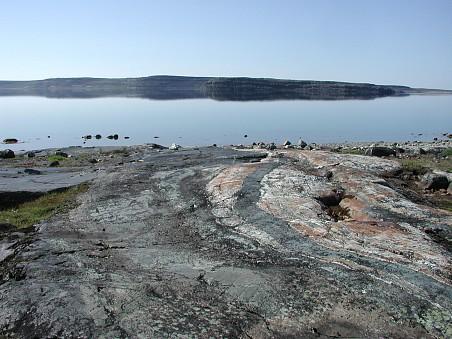Metamorphic petrologists have known since their branch of geology emerged that the intensity or ‘grade’ of metamorphism varies with position in an orogenic belt. This is easily visualised by the sequence mudstone-shale-slate-phyllite-schist-gneiss that results from a clay-rich starting material as metamorphic grade increases. Very roughly speaking, the sequence reflects burial, heat and pressure, and must have been controlled by temperature increasing with depth and pressure: the geothermal gradient. In turn, that depends on internal heat production, geothermal heat flow and the way in which heat is transferred through the deep crust: by thermal conduction or mechanical convection. A particular rock composition gives rise to different metamorphic mineral assemblages under different temperature and pressure conditions.
George Barrow was the first to recognise this in the Southern Highlands of Scotland as a series of zones marked by different index minerals. For instance, in once clay-rich sediments he recognised a succession of new minerals in the sequence chlorite; biotite; garnet; staurolite; kyanite; sillimanite in rocks of progressively higher metamorphic grade. Barrow found that once basaltic lavas interleaved with the sediments displayed zones with different characteristic minerals. Other metamorphic terrains, however, revealed different index minerals. Experimental mineralogy eventually showed that Barrow’s zones and others reflected a wide range of chemical reactions between minerals that reach equilibrium over different combinations of pressure and temperature. This enabled geologists to distinguish between metamorphism that had occurred under conditions of high-pressure and low-temperature, low-P and high-T and intermediate conditions (see diagram). This suggested that metamorphic rocks can form in areas with different heat flow and geothermal gradients. Geochemical means of assessing the actual temperatures and pressures at which particular rocks had reached mineralogical equilibrium, known as ‘thermobarometry’, now enable such variations to be assessed quantitatively.

It has long been suspected that the average T/P conditions revealed by metamorphic rocks have varied over geological time, as well as from place to place at any one time. A recent paper has analysed thermobarometric data from the earliest Archaean to recent times (Brown, M. et al. 2020, Evolution of geodynamics since the Archean: Significant change at the dawn of the Phanerozoic: Geology, v. 48, p. 488–492; DOI: 10.1130/G47417.1) They conclude that from the Archaean to the start of the Neoproterozoic the average P/T ratio was more than twice as high as it was in the following billion years. At about 2 Ga they suggests a relatively sudden decrease that correlates with what they regard as the first major assembly of continental crust: the Columbia (Nuna) supercontinent. The Mesoproterozoic Era, occupied by the disassembly of Columbia and the eventual creation of the Rodinia supercontinent, retained a high mean T/P. That began to decline with the break-up of Rodinia and a succession of tectonic cycles of ocean opening and closing during the Neoproterozoic and the Phanerozoic. This phase of truly modern plate textonics saw first the assembly of Gondwana and then the all-encompassing Pangaea, followed by its break up as we witness today. There are other correlations with the T/P variations, but they need not detain us.
The raw metamorphic data (564 points spanning 3.5 Ga) are by no means evenly spaced in time, and four dense clusters of points show a very wide spread of T/P – up to 2 orders of magnitude. Yet the authors have used locally weighted scatterplot smoothing (LOWESS) to reduce this to a smoothed curve with a zone of uncertainty that is a great deal narrower than the actual spread of data. Frankly, I do not believe the impression of systematic change that this approach has produced, though I am not a statistician. To a lesser extent than me, it seems that neither does Peter Cawood, who comments on the paper in the same issue of Geology: more clearly than do the authors themselves.

Cawood’s view is that it was all due to a steady fall in mantle temperature and related broad changes in tectonic processes. But metamorphic rocks form in only the outermost 100 km of the Earth. The post-800 Ma examples include a much greater proportion of those formed under high- and ultrahigh pressures – blueschists and various kinds of eclogite – than do the earlier metamorphic belts. This weights the post-800 Ma record to lower mean T/P. Such rocks form in subduction zones and their high density might seem to doom them to complete resorption into the deep mantle. Yet large chunks now end up embedded in continents, interleaved with less extreme materials. Cawood suggests, as do others, that cooling of the mantle has enabled deeper break-off of subducted slabs to meet their end at the core-mantle boundary. The retained low T/P lithosphere since 800 Ma may have been sliced into the continents by increased underthrusting during continent-continent collisions that dominate the more modern orogenic-metamorphic belts.
See also: Cawood, P.A. 2020 Earth Matters: A tempo to our planet’s evolution: Geology, v. 48, p. 525–526; DOI: 10.1130/focus052020.1










